
Original Link: https://www.anandtech.com/show/2378
AMD's Phenom Unveiled: A Somber Farewell to K8
by Anand Lal Shimpi on November 19, 2007 1:25 AM EST- Posted in
- CPUs
It's surreal isn't it? Is this how you pictured it? With forty-three days left in the year, AMD is finally letting us publish benchmarks of its long awaited Phenom microprocessor. The successor to K8, AMD's most successful micro-architecture to date, and the cornerstone of AMD's desktop microprocessor business for 2008: Phenom is here.
But shouldn't there be fireworks? Where's the catchy title? The Star Wars references were bound to continue right? Why were there no benchmarks before today, why are the next several pages going to be such a surprise?
AMD had been doing such a great job of opening the kimono as its employees liked to say, giving us a great amount of detail on Barcelona, Phenom and even the company's plans for 2008 - 2009. The closer we got to Phenom's official launch however, the quieter AMD got.
We were beginning to worry, and for a while there it seemed like Phenom wouldn't even come out this year. At the last minute, plans solidified, and we received our first Socket-AM2+ motherboard, with our first official Phenom sample. What a beautiful sight it was:
These chips are launching today, with availability promised by the end of the week. Phenom today is going to be all quad-core only, you'll see dual and triple-core parts in 2008 but for now this is what we get.
The architecture remains mostly unchanged from what we've reported on in the past. This is an evolutionary upgrade to K8 and we've already dedicated many pages to explaining exactly what's new. If you need a refresher, we suggest heading back to our older articles on the topic.
The Long Road to Phenom
Ever wonder why we didn't have an early look at Phenom like we did for every Core 2 processor before the embargo lifted? Not only are CPUs scarce, but AMD itself didn't really know what would be launching until the last moment.
At first Phenom was going to launch at either 2.8GHz or 2.6GHz; then we got word that it would be either 2.6GHz or 2.4GHz. A week ago the story was 2.4GHz and lower, then a few days ago we got the final launch frequencies: 2.2GHz and 2.3GHz.
Then there's the pricing; at 2.2GHz the Phenom 9500 will set you back $251, and at 2.3GHz you'd have to part with $283 (that extra 100MHz is pricey but tastes oh so good).
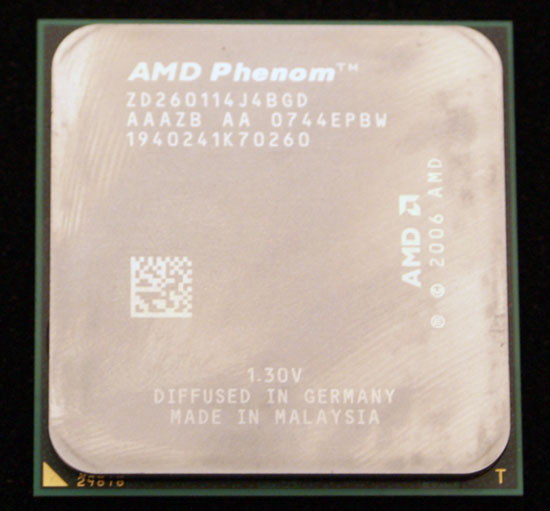
The problem is, and I hate to ruin the surprise here, Phenom isn't faster than Intel's Core 2 Quad clock for clock. In other words, a 2.3GHz Phenom 9600 will set you back at least $283 and it's slower than a 2.4Ghz Core 2 Quad Q6600, which will only cost you $269. And you were wondering why this review wasn't called The Return of the Jedi.
AMD couldn't simply get enough quantities of the Phenom at 2.4GHz to have a sizable launch this year (not to mention a late discovery of a TLB error in the chips), and the company was committed to delivering Phenom before the holiday buying season as these are tough times and simply waiting to introduce its first quad-core desktop parts was just not an option. Rather than paper launch a 2.4GHz part, AMD chose to go with more modest frequencies, promising faster, more competitive chips in Q1 2008. It's not the best PR story in the world, but it's the honest truth.
Two more quad-core Phenoms will come out in Q1: the 9900 and 9700, clocked at 2.6GHz and 2.4GHz respectively. The Phenom 9900 will be priced below $350 while the 9700 will be a sub-$300 part. As you can probably guess, the introduction of those two will push down the pricing of the 9600 and 9500, which will help Phenom be a bit more competitive.
It's worth mentioning that in the 11th hour AMD decided to introduce a multiplier-unlocked version of the Phenom 9600 sometime this year that will be priced at the same $283 mark. Whether or not it's called a Black Edition is yet to be determined.
Intel Responds with...really?
Surely Intel wouldn't allow AMD to simply come within the range of being competitive this late in the year. I honestly expected Intel to combat today's launch with something, something serious, something sinister. And indeed it did.
But instead of sampling a Core 2 Quad Q9450, the upcoming Penryn replacement to the Q6600, and instead of even further dropping prices to completely ruin the Phenom launch party Intel responded in a way that actually doesn't make much sense: by sampling a $1000+ Extreme CPU, the Core 2 Extreme QX9770 (click here for our review).
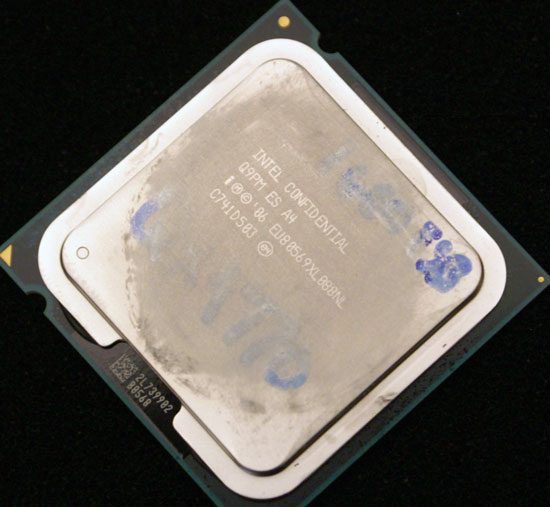
The QX9770, 1600MHz FSB and 3.2GHz, just salting the wounds
Running at 3.2GHz with a 1600MHz FSB (up from 3.0GHz/1333MHz of its recently released predecessor, the QX9650), the QX9770 isn't schedule for release until next year and we do know that it'll carry a price tag of over $1000. The timing of Intel's launch is obviously to disrupt AMD's Phenom thunder, but the most important part of Intel sampling QX9770s has nothing to do with the chips themselves, but rather the act.
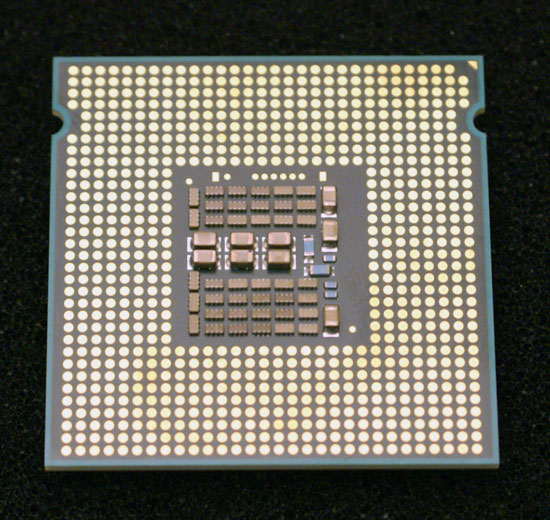
Almost as soon as we had Phenom samples, Intel made the decision to sample a CPU requiring a FSB that wasn't officially supported by any chipset at the time. No, 1600MHz FSB support won't come until next year with the X48 chipset, but it didn't matter to Intel; we were getting chips now.
Take a moment to understand the gravity of what I just said; Intel, the company that would hardly acknowledge overclocking, was now sampling a CPU that required overclocking to run at stock speeds. Even more telling is that Intel got the approval of upper management to sample these unreleased processors, requiring an unreleased chipset, in a matter of weeks. This is Intel we're talking about here, the larger of the two companies, the Titanic, performing maneuvers with the urgency of a speed boat.
It's scary enough for AMD that Intel has the faster processor, but these days Intel is also the more agile company.
First Tunisia, then Tahoe?
As a slightly off-topic but important sidenote, I thought it would be appropriate to let everyone know how AMD wanted this review to happen, and how certain folks within AMD were champions for the right cause and made it actually happen.
AMD knew it wouldn't be able to trounce Core 2 with Phenom, especially not at 2.3GHz, so it wanted to control the benchmarking that was done on Phenom. For the first time in as far as I can remember, AMD wanted all benchmarking on Phenom to be done at a location in Tahoe, of course on AMD's dime. AMD would fly us out there, we would spend a couple of days with a pre-configured system and we'd head home to write our stories.
Now I championed for this sort of early-access to Phenom months ago. I've visited AMD alone three times this year primarily to talk about Phenom, and each time I left without being able to report so much as a single benchmark to you all (everyone remembers those articles right?). I tried and tried to get AMD to part with some early Phenom data, because they were losing the confidence of their fan base and that's a sad thing to see for a company that really took care of this community when we needed it most.
After Tahoe AMD would eventually sample Phenom parts so we could test in our own labs, but there was no word on exactly when that would be. Chances are you would've seen a handful of numbers here today if we had gone to Tahoe with a full review of the chip hitting sometime in December.
Needless to say, I wasn't happy. I refused to go to Tahoe.
Don't get me wrong, a free trip to Tahoe is a wonderful thing, but Phenom deserved better. It deserved dedicated testing, it deserved a thorough review, not a quick glance over a couple of days. And I had a feeling that you all would agree. The time for AMD-sanctioned testing expired months ago, if Phenom was launching this week, we were going to have a proper review of it.
These days, AMD seems to be learning a little too much from the ATI way of doing things. If AMD had its way, today's Phenom review would have been done from beautful Lake Tahoe, on a system that AMD built, running at a frequency that isn't launching. Now there's nothing wrong with allowing us to preview Phenom under closed conditions, after all, Intel does it, but that's simply not acceptable for a review of a product that's four days away from being in stores. You all want to see a thorough review of Phenom, not some half-assed preview, definitely not after waiting this long for it.
An AMD rep, familiar with the Tahoe trip, asked me, somewhat surprised, "what, Intel doesn't work like this?".
Sorry to say, Intel doesn't. Today Intel let us preview the Core 2 Extreme QX9770 processor, do you want to know how they did it? The FedEx guy dropped off a chip. No flights to Tahoe, no hotel rooms, no expenses at all. Don't get me wrong, I felt like an idiot turning down a free trip to Tahoe, but it was for AMD's own good. We've all seen the financials, these aren't times to be wasting money on silly trips around the country, it costs less than $30 to ship a CPU and that's all we need.
I get the point of Tahoe, it's to control the benchmarking, making sure we wouldn't be comparing a 2.4GHz Phenom to a 3.0GHz Penryn, but honestly folks - would we really do that to begin with? And I get the idea to wine and dine the press, with hopes of more pleasant reviews with better relationships - but this isn't a product to toy with. We're here to do our jobs and that is to review the product that will carry AMD for the next twelve months, and honestly we can't do that from some lodge somewhere away from our testbeds.
This isn't the first time AMD has heard of this from me, and there are many within AMD who feel the same way. The reason you're finding this rant in here today is because I am concerned for the future of the company. Competition is a good thing, we need to keep it around, but AMD needs to learn from its competitors. Intel and NVIDIA don't try things like this, business is always first with them, frivolous pleasures come next.
To AMD: if you want to be Intel, start acting like it.
Socket-AM2+, Not So Positive?
When AMD first started talking about Phenom it boasted backwards compatibility with current Socket-AM2 motherboards, as well as a new Socket-AM2+ platform that would enable higher performance and better power management.
We are currently looking into Socket-AM2 motherboard compatibility, but not all vendors have Phenom-ready code for their motherboards as of today. While Phenom should work in virtually all Socket-AM2 motherboards, it's tough to say which will work by the time you can actually buy these things.

AMD's Spider platform, well, minus the graphics card - the 8800 GTX is still our testbed GPU of choice.
Socket-AM2+ motherboards, most of which are based on AMD's new 790FX chipset, were supposed to bring a tangible performance increase when paired with a Phenom processor. Phenom's L3 cache and North Bridge work on the same power plane, one separate from the rest of the CPU. Socket-AM2+ enables the use of two separate voltages, one for the L3 cache/NB and one for the rest of the CPU, whereas Socket-AM2 motherboards run the entire chip at the same voltage. The original plan was for Socket-AM2+ motherboards to run the L3 cache/NB at a higher frequency than the rest of the chip, unfortunately it looks like AMD wasn't able to make that happen.

Socket-AM2+ in action
Currently, the L3 cache/NB on these chips runs at a fixed frequency that's actually lower than the rest of the CPU frequency: 2.0GHz. We tested Phenoms running from 2.2GHz all the way up to 2.6GHz, and in all cases the L3 cache and North Bridge ran at 2.0GHz. We're not sure if this will ever get fixed, but it's somewhat disappointing as it was supposed to be a major reason for upgrading to Socket-AM2+ (but it's good news for current AM2 owners).
Right now it looks like the only benefit to Socket-AM2+ is support for DDR2-1066, which we've been having problems with internally already. If you've got a good Socket-AM2 motherboard, you may not need to upgrade to get the most out of Phenom.
Overclocking
Given the launch frequencies, you can expect that Phenom isn't a tremendously overclockable chip.
While we were able to run our 2.4GHz chip at 3.0GHz, we couldn't get it stable. Even 2.8GHz wasn't entirely stable, but 2.6GHz was attainable for benchmarks.
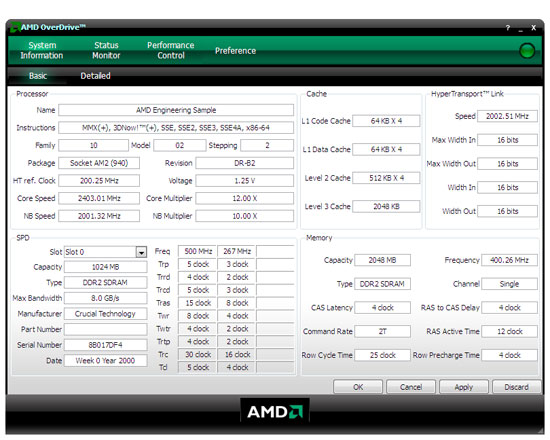
AMD's OverDrive Utility, note that it reads the memory controller as single channel because Phenom actually has two independent 64-bit memory controllers instead of a single 128-bit one. Current BIOSes and the AMD utility incorrectly report this as being single-channel.
All of our overclocking was done using AMD's nifty new OverDrive utility, which is a Windows utility that can control virtually every single BIOS option from within your OS. You can overclock individual cores, change memory timings, voltages and most importantly: it all works.
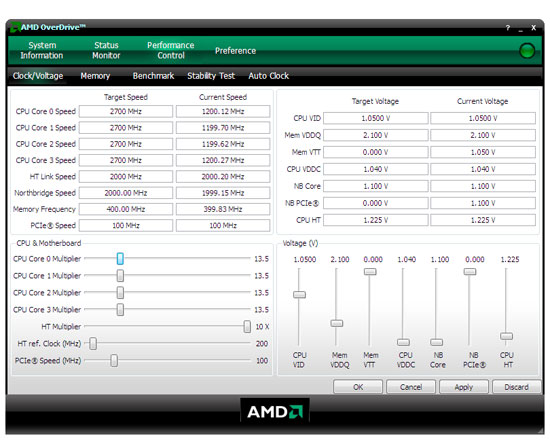
The application is a little slow to respond when making changes and it would be nice if there was a hotkey to bypass the application loading its last settings, but it's truly a beauty to work with and one of the best aspects of today's launch.
The Test
| CPU: | AMD Phenom 9900 (2.6GHz) AMD Phenom 9700 (2.4GHz) AMD Phenom 9600 (2.3GHz) AMD Phenom 9500 (2.2GHz) Intel Core 2 Quad Q9450 (2.66GHz/1333MHz) Intel Core 2 Quad Q6700 (2.66GHz/1066MHz) Intel Core 2 Quad Q6600 (2.40GHz/1066MHz) |
| Motherboard: | ASUS P5E3 Deluxe (X38) MSI K9A2 Platinum (790FX) |
| Chipset: | Intel X38 AMD 790FX |
| Chipset Drivers: | Intel 8.1.1.1010 (Intel) AMD 790FX Launch Drivers |
| Hard Disk: | Western Digital Raptor 150GB |
| Memory: | Corsair XMS2 DDR2-800 4-4-4-12 (1GB x 2) Corsair XMS3 DDR3-1066 7-7-7-20 (1GB x 2) |
| Video Card: | NVIDIA GeForce 8800 GTX |
| Video Drivers: | NVIDIA ForceWare 169.09 |
| Desktop Resolution: | 1920 x 1200 |
| OS: | Windows Vista Ultimate 32-bit |
General Application Performance
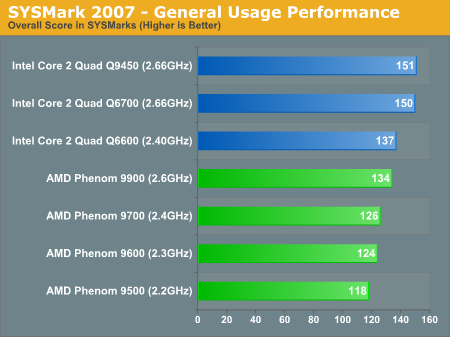
Right off the bat the numbers aren't looking good for AMD. The Phenom 9600 is priced closest to the Core 2 Quad Q6600, but unfortunately for AMD the Q6600 outperforms it by a healthy 10%. AMD needs a 2.6GHz Phenom to equal the performance of the Q6600, but the 9900 won't be out until next year, when it'll have to face the Penryn based Q9450 and Q9300.
2D Image Manipulation Performance
Once again we broke out the Retouch Artists Photoshop CS3 benchmark, timing a handful of image manipulation operations in CS3:

The Core 2 Quad Q6600 is around 6% faster than the Phenom 9900, 10% faster than the Phenom 9700, and almost 16% faster than the Phenom 9600 which is its closest price competitor throughout the rest of 2007.
Media Encoding Performance
We'll start with our DivX test; this is the same benchmark we've been running for years, we've simply updated to DivX 6.7. The codec was set to Unconstrained quality, with the quality/performance slider at 5 and enhanced multi-threading enabled. The rest of the codec settings remained at their defaults.
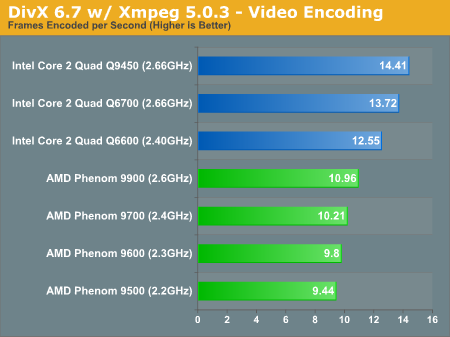
Despite the move to four cores and the improvements to the K8 architecture, the Phenom, even at 2.4GHz, is slower than the Core 2 Quad Q6600. Clock for clock, Intel has a 24% performance advantage here.
AMD did make some progress however, if we look back at some of our older numbers the gap at 3.0GHz between dual-core chips was almost 38%.
The situation gets even more bleak once you take into account that the Phenom 9700 will most likely ship when Intel's Q9450 is also available which extends Intel's lead to over 30%.
AMD has always been much more competitive at encoding using Microsoft's Windows Media Video codec:

Windows Media Encoder performance is virtually identical between the Phenom and Core 2 Quad at the same clock speed. However, once you take price into account, Intel starts to pull ahead; the Q6600 is priced competitively with the Phenom 9600 and manages a 7% performance advantage over the 9600. It's not much, but the Q6600 is also cheaper.
Our final encoding test is an increasingly popular format: x264. We encode the same .avi file from our WME test but this time using the x264 codec and AutoMKV. We didn't encode audio and left all program settings at its defaults, the only thing we changed was we asked that the final file size be 100MB (down from 500MB).
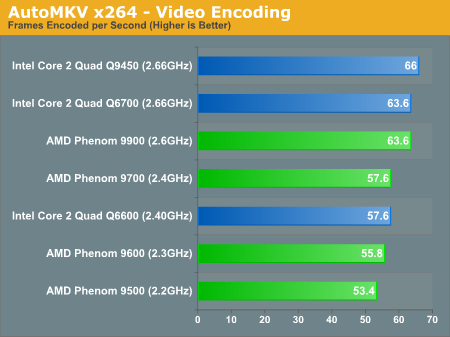
Much like our WME results, clock for clock AMD's Phenom actually equals the performance of the Core 2 Quad. Take price into account and Intel is still the right buy; it's tough to say what will happen when the Phenom 9700 and 9900 eventually launch because they may be competing against Penryn at that time, which in this case would be the Q9450, a more formidable opponent.
3D Rendering Performance
We'll start off our look at 3D rendering performance with the latest version of Cinebench, we ran the single and multi-threaded benchmarks and reported the scores below:
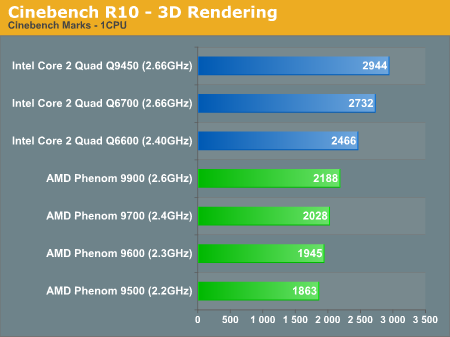
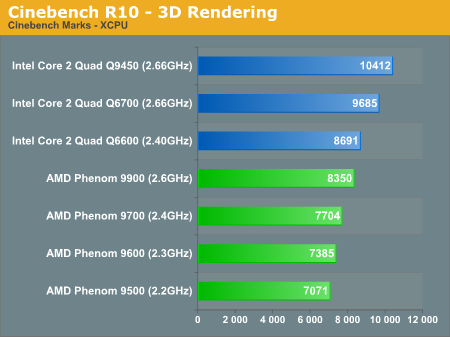
Single threaded performance goes to Intel, highlighting a theme you've probably already noticed thus far: Core 2 is far more efficient per clock than Phenom. AMD would need to be at around 2.8 - 2.9GHz to equal the performance of the Core 2 at 2.4GHz in this particular benchmark, even the Phenom 9900 can't cut it.
Looking at the multi-threaded results we see that AMD does gain some ground, but the standings remain unchanged: Intel can't be beat. We can actually answer one more question using the Cinebench results, and that is whether or not AMD's "true" quad-core (as in four cores on a single die) actually has a tangible performance advantage to Intel's quad-core (two dual-core die on a single package).
If we look at the improvement these chips get from running the multi-threaded benchmark, all of the Phenom cores go up in performance by around 3.79x, while all the Intel processors improve by around 3.53x. There's a definite scaling advantage (~7%), but it's not enough to overcome the inherent architectural advantages of the Core 2 processors.
3dsmax 9
As always we have our 3dsmax 9 test, using SPECapc's 3dsmax 8 benchmark files. The numbers we're reporting below are strictly the CPU rendering composite scores:

Here the Phenom 9900 is basically as fast as the Core 2 Q6600, unfortunately for AMD the 9900 doesn't launch until next year and it will launch at a price greater than the Q6600. AMD needs help cutting prices fast if it expects Phenom to remain competitive in the eyes of everyone who doesn't own a Socket-AM2 motherboard.
Lightwave 9.5
We see a similar story in our Lightwave benchmarks, the Phenom 9900 at best can equal the performance of the Q6600 but at worst it looks like AMD needs another 200 - 300MHz to catch up to Intel's cheapest quad-core:
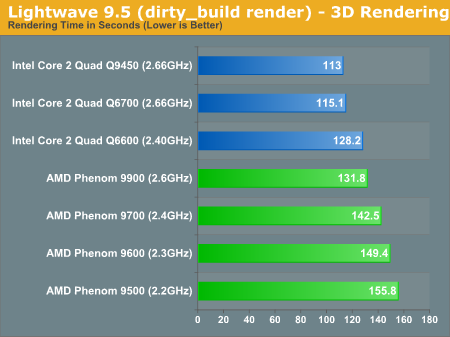
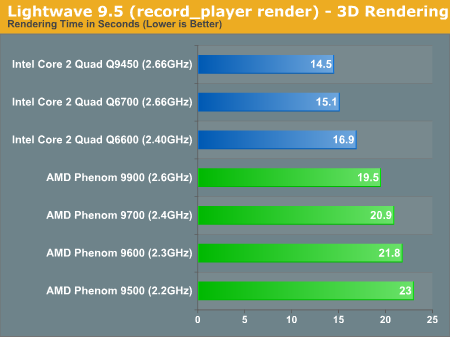
POV-Ray
The POV-Ray benchmark is quite possibly the least kind to AMD out of the group:
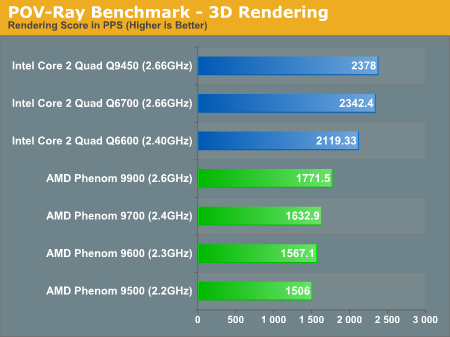
Intel's Q6600 is 20% faster than AMD's fastest Phenom due out in Q1, it's 30% faster than Phenom at the same clock speed, and 35% faster at the most competitive price point.
Gaming Performance
To highlight CPU performance differences, all of our 3D gaming benchmarks were run at 1024 x 768, so keep in mind that real world gameplay will most likely be at more GPU bound resolutions with CPU differences mattering less. That being said, this is a CPU review, so we do want to know which of these chips runs game-code the best.
It turns out that gaming performance is really a mixed bag; there are a couple of benchmarks where AMD really falls behind (e.g. Half Life 2 and Unreal Tournament 3), while in other tests AMD is actually quite competitive (Oblivion & Crysis).
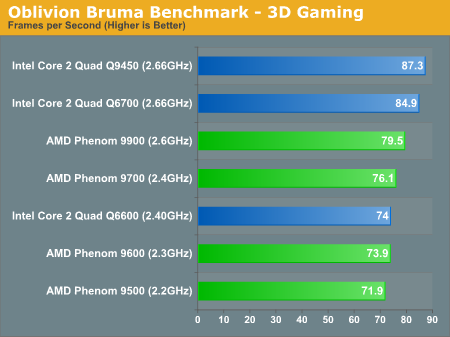
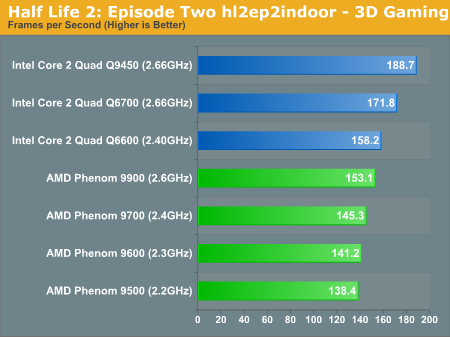

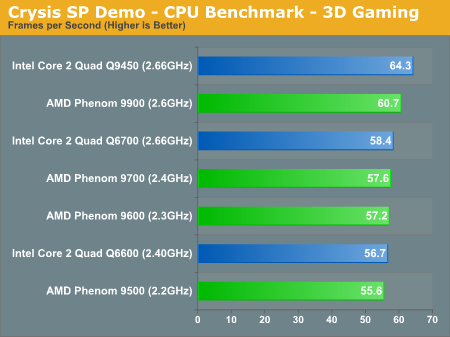
While Phenom suffers greatly in video encoding and 3D rendering tests, there is hope for it as the 9700 can actually compete clock-for-clock with Core 2 in some games. If all you do is game on your machine, with the right video cards you'd be hard pressed to notice the difference between a Phenom and a Core 2 system - that being said, if you're looking at quad-core, chances are that you're doing something else with your system other than game.
Power Consumption
At idle, the Phenom's power consumption is competitive with Intel's quad-core, but under load Intel takes the cake. Power consumption will only get better for Intel with Penryn, without a doubt we'll see improvements to Phenom's power consumption as yields improve and production increases just as we did with K8.
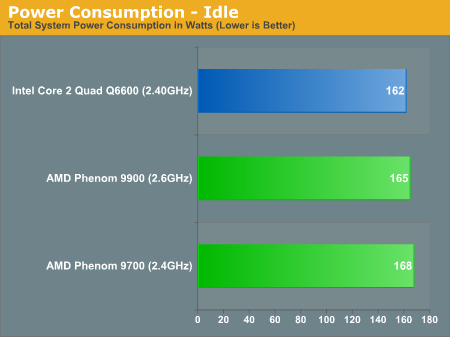
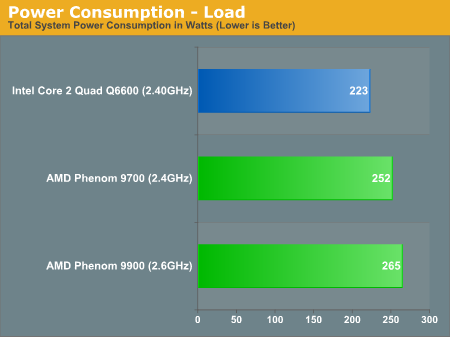
Final Words
If you were looking for a changing of the guard today it's just not going to happen. Phenom is, clock for clock, slower than Core 2 and the chips aren't yet yielding well enough to boost clock speeds above what Intel is capable of. While AMD just introduced its first 2.2GHz and 2.3GHz quad-core CPUs today, Intel previewed its first 3.2GHz quad-core chips. We were expecting Intel to retain the high end performance crown, but also expected AMD to chip away at the lower end of the quad-core market - today's launch confirms that Intel is still the king of the quad-core market.
As we've seen from our mainstream CPU comparisons however, all of this could change with some clever pricing - something AMD seems to have forgone with its Phenom launch.
Phenom manages to fill a major gap in AMD's desktop CPU product lineup: the company can now offer quad-core CPUs. And with the needed updates to the K8 architecture AMD is now competitive in some areas that it sorely needed improving in. Windows Media and x264 encoding are both strong points of the Phenom architecture, making it on par with Intel's quad-core offerings. The same can be said about some games, but at the same time Intel really pulls ahead in our DivX and other game tests.
Inevitably some of these Phenoms will sell, even though Intel is currently faster and offers better overall price-performance (does anyone else feel weird reading that?). Honestly the only reason we can see to purchase a Phenom is if you currently own a Socket-AM2 motherboard; you may not get the same performance as a Core 2 Quad, but it won't cost as much since you should be able to just drop in a Phenom if you have BIOS support.
If you ask AMD, this is platform story; after all, who wouldn't want to combine a Phenom with the 790FX chipset and a pair of Radeon 3850 graphics cards. The problem is that you can pair up 3850s on an Intel chipset just as easily, leaving the biggest benefit to 790FX the ability to run 3 or 4 3850s, which we're not even sure is a good idea yet. There are some auto-overclocking features, but talking about Phenom's overclocking isn't really accenting one of its strong points. The platform sell is a great one to an OEM, but it's simply not compelling enough to the end user - if Phenom were more attractive, things would be different.
To make the CPU more attractive AMD desperately needs to drop the price, and from what we've heard, that will happen in Q1. From what we've seen, AMD needs to be at least 200MHz ahead of Intel in order to remain competitive - that means bringing out a Phenom 9900 that's cheaper than the Q6600, at least. If AMD can do that, it's quite possible that in early 2008 we'll have the first sub-$200 quad-core part as the 9500 drops in price.
Oh and just in case AMD is listening: the Phenom 9600 has no business being here, the extra 100MHz only clutters up the product line. Once the 9700 and 9900 are out let's try and stick to 200MHz increments shall we?
Here's what really frightens us: the way AMD has priced Phenom leaves Intel with a great opportunity to increase prices with Penryn without losing the leadership position. Intel could very well introduce the Core 2 Quad Q9300 (2.33GHz) at $269 and still remain quite competitive with Phenom, moving the Q9450 into more expensive waters. Intel has't announced what it's doing with Penryn pricing in Q1, but our fear is that a weak showing from Phenom could result in an upward trend in processor prices. And this is exactly why we needed AMD to be more competitive with Phenom.
It's tough to believe that what we're looking at here is a farewell to the K8. When AMD first released the Athlon 64, its performance was absolutely mind blowing. It kept us from recommending Intel processors for at least 3 years; Phenom's arrival, however, is far more somber. Phenom has a difficult job to do, it needs to keep AMD afloat for the next year. Phenom is much like the solemn relative, visiting during a time of great sorrow within the family; let's hope for AMD's sake that it can lift spirits in the New Year.







